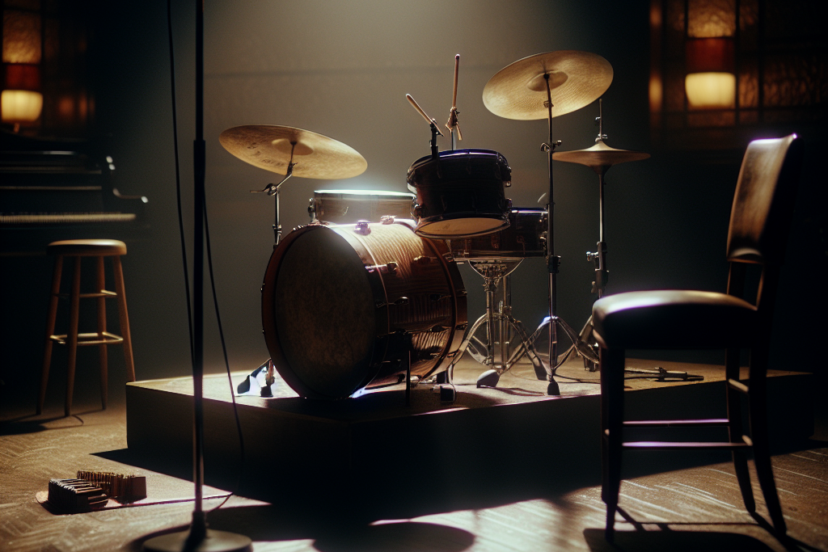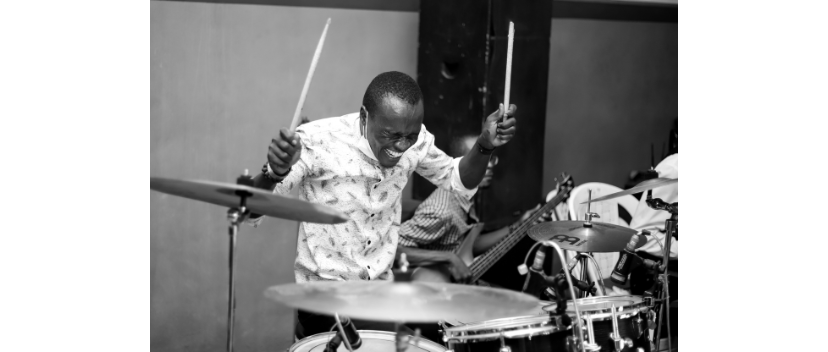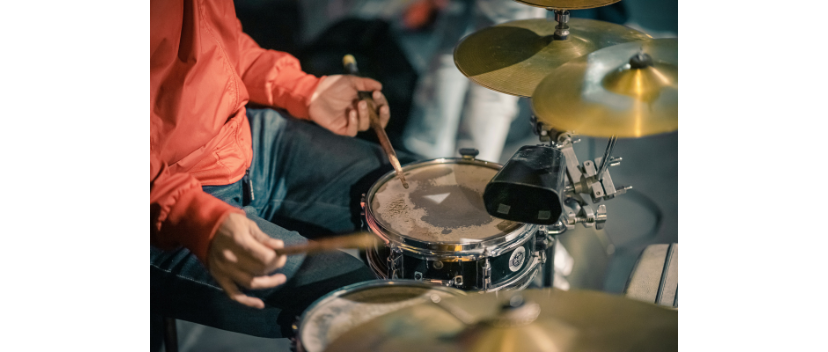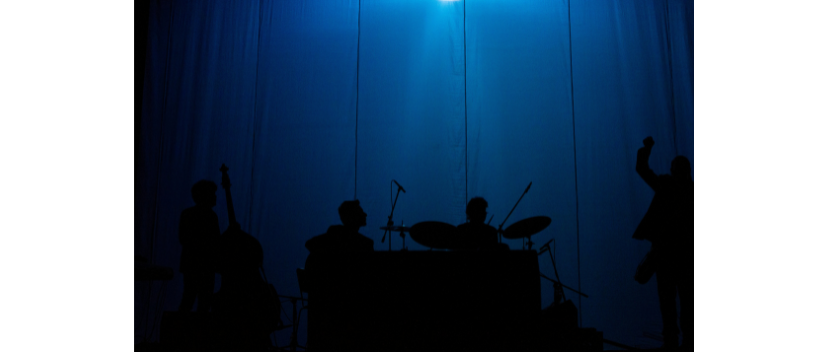In the world of music production, beats are the backbone of countless tracks across various genres,…
Jazz Drums 101: History, Techniques & Equipment Explained

Key elements of playing jazz drums include syncopation, improvisation, swing feel, and a deep understanding of jazz rhythms. It’s essential to master techniques like brushes, ride cymbal patterns, and ghost notes. Jazz drummers also need to listen actively and interact with other musicians in the band dynamically.
Key Highlights
- Jazz drumming stands out as a special kind of drumming that’s all about making things up on the spot and playing along with other musicians.
- With its roots in New Orleans around the late 1800s, jazz drumming came to life through a mix of African, Cuban, and American influences.
- Over time, how people played jazz drums changed quite a bit. It went from early styles like ragtime to bebop changes and then onto what we know as modern jazz drumming today.
- Famous names in jazz like Baby Dodds, Max Roach, and Art Blakey have really left their mark on this music style.
- When it comes to playing techniques for jazz drums such as using different ways to hold the sticks or how to use brushes create those smooth swing rhythms that are key in jazz tunes.
- For their gear setup includes specific pieces: A basic kit has bass drums snare rack tom floor tom ride cymbals crash hi-hats. They often go for thinner cymbals coated heads get just right sound.
Introduction
Jazz drumming is all about the excitement and flexibility that comes from playing drums in jazz music. It’s known for being spontaneous, having complex beats, and working closely with other band members on the spot.
This style lets drummers really get creative with their drum set and explore new musical territories, including the fusion of jazz with other genres such as rock and funk, known as jazz fusion.
The story of jazz drumming starts in New Orleans around the late 1800s. The city was buzzing with a mix of African, Cuban, and American tunes which led to the creation of jazz’s distinct sound. Elements like African rhythms, Cuban beats, and American marching styles were key in forming what early jazz drumming sounded like.
As time went by, how people played drums in jazz changed quite a bit. From early ragtime to bebop changes right through to today’s modern approach; each era saw drummers breaking new ground on their kits. They came up with fancy fills between beats (drum fills), tricky patterns (complex rhythms), and a special way of making everything swing that you don’t find elsewhere. This evolution of styles of drumming has led to the development of various techniques and approaches, making jazz drumming a diverse and dynamic art form.
The Evolution of Jazz Drums
In this blog post we’re diving into where it all began for jazz drumming, tracking how its techniques have morphed over time while shining light on some legendary jazz drummer figures along the way .
We’ll also break down important skills needed for playing these types of drums such as different ways to hold your sticks or using brushes instead , plus look at what kind equipment they use – think: those cool-looking cymbals!
So whether you play yourself or just love learning about different kinds of music , there’s something here everyone can groove too when it comes exploring more about the drum set used across various eras within jazz music.

The Origins of Jazz Drumming
Jazz drumming started out in the lively city of New Orleans, Louisiana, back in the late 1800s. This place was like a big mixing bowl of different cultures and music styles which were super important for jazz music to grow and find its own beat. The rhythms from Africa that came over with enslaved people mixed up with Cuban beats and the style of American marching bands.
Together, they made this special sound we know as jazz drumming, which later evolved into different styles such as Latin jazz. What’s cool about it is how all these different bits come together to let musicians play around – or improvise – with complex beats that make you want to move, thanks to their off-beat rhythm patterns.
The Birth of Jazz in New Orleans
In New Orleans, often called the birthplace of jazz music, there was a lot of musical creativity happening in the late 1800s. Jazz came about as a way for African-Americans to express their feelings and experiences with racism, segregation, and discrimination.
At the heart of jazz drumming was the drum set – made up of a bass drum, snare drum, hi-hat, and cymbals. This setup became crucial in giving jazz its rhythm. Drummers from New Orleans were key in developing what we now recognize as early jazz sound by mixing African and Caribbean beats into their performances. They crafted a distinctive style that paved the way for all kinds of techniques used by future musicians on the drums.
Key Influences: African, Cuban, and American Roots
Jazz drumming really took off thanks to a mix of influences from Africa, Cuba, and America that all came together in New Orleans. The rhythms from Africa were brought over by enslaved Africans and they laid the groundwork with their syncopated beats and complex patterns for what would become jazz drumming.
From Cuba, there was this cool variety of percussion instruments and intricate rhythms that made the music pop even more. Then you have the American march style which is all about being precise like military drummers; it played a big part in shaping how the drum set was used in jazz music.
All these different sounds merged to create something special that still defines what jazz drumming is all about today.
Evolution of Jazz Drumming Techniques
Over the years, jazz drumming has really changed and grown. It’s like it mirrors all the new stuff happening in jazz music itself.
Back when bebop was all the rage, with its quick beats and tricky chords, drummers had to step up their game big time. They came up with these detailed drum fills and even solo parts that were pretty cool.
Then as we moved into what people call modern jazz, playing drums became more about keeping pace with the band—this is known as comping—and weaving together complex beat patterns that make you want to move.
Nowadays, when you listen to modern jazz drumming, you’ll hear bits of different styles mixed in there too; things like funk vibes or Latin grooves are common finds on a drummer’s set list now! This whole journey shows just how much creativity goes into playing those drums sets across every era of jazz music, including the important technique of drum comping.
From Ragtime to Bebop: A Technical Journey
The story of how jazz drumming has changed starts with the ragtime period and goes all the way to the bebop movement. Back in ragtime, it was all about catchy rhythms and piano tunes that made you want to move. This style really set up what jazz drumming would become, focusing on making things up as you go along and playing complex beats.
When we moved into the bebop era, drummers like Max Roach and Art Blakey took things to a whole new level with their super detailed drum fills and solo parts. Bebop brought us quicker tempos, tricky chord changes, and show-off skills which paved the way for all the cool techniques used in modern jazz drumming today, including the subgenre of cool jazz.
The Shift to Modern Jazz Drumming
In modern jazz drumming, the spotlight has shifted away from showy drum fills and solo performances. Instead, it’s all about working together with the band. Drummers now focus on comping or backing up their fellow musicians by weaving complex rhythmic patterns that really bring out the best in a song.
At the heart of this style is the ride cymbal, which keeps a steady beat that pushes the music along with quarter notes and a subtle 8th note triplet feel. As new styles like fusion came into play, drummers started mixing in bits from funk, Latin beats, and other sounds. This blend not only broadened what jazz drumming could be but also made its sound richer and more varied.

Iconic Jazz Drummers and Their Contributions
In the world of jazz drumming, a few legendary figures have really made their mark and changed how we think about this music.
Baby Dodds was at the forefront, bringing in complex bass drum beats and off-beat rhythms that set him apart.
Then there’s Max Roach, who took bebop drumming to new heights with his skillful play and impressive solo performances on drums.
Art Blakey is another name you can’t forget; through his work with the Jazz Messengers, he introduced a hard bop style that focused on strong and energetic playing.
Another iconic jazz drummer is Roy Haynes, known for his innovative and dynamic playing style that has influenced countless musicians in the jazz world.
Baby Dodds and the Early Days
Baby Dodds was a trailblazer in the world of jazz drumming, making a big impact right from the start. With his drum set, he really focused on using the bass drum to add depth and complexity to jazz music. By weaving together complicated patterns on the bass drum, playing rhythms that catch you off guard, and bringing lots of energy into his performances, Dodds created a sound that was all his own. This made him stand out among other jazz drummers back then. His work didn’t just stop with him; it built a strong foundation for future generations of musicians who look up to him even today for inspiration in jazz music and beyond.
Max Roach and the Bebop Revolution
Max Roach was a legendary jazz drummer who played a key role in the bebop movement and shaping modern jazz drumming. He was famous for his skillful playing and amazing drum solos, taking what could be done on a drum set to new heights. With an original approach to rhythm, he introduced complex time signatures and detailed drum fills that became benchmarks for bebop style. Drummers all over the world still look up to him today, drawing inspiration from his work. Max Roach’s name is solidly established as one of the greatest in jazz drumming history because of these contributions.
Art Blakey’s Hard Bop Influence
Art Blakey really made his mark on jazz drumming as the powerhouse behind the Jazz Messengers. He was famous for bringing a lot of energy and punch to his playing style. With his knack for mixing up complex rhythms, delivering intricate drum fills, and laying down some heavy grooves, he stood out as a major influence in jazz music. Besides being an amazing drummer, Blakey played a big role in shaping future stars by guiding and motivating young musicians who joined the Jazz Messengers. His contribution to hard bop and beyond has left an enduring legacy that continues to inspire many in jazz drumming today.
Jazz Drumming Techniques Explained
In jazz drumming, there are lots of different ways to play, and each one has its own special touch. For starters, two popular methods are the traditional grip and the matched grip. With the traditional grip, which you see a lot in older jazz music, you hold one of your sticks underneath your hand. On the other hand (no pun intended), with the matched grip that’s more common in today’s jazz scenes, both sticks are held the same way by both hands side by side. Then there’s using brushes – this is key for getting that soft and detailed sound perfect for slow songs or swing grooves. Another important technique in jazz drumming is the basic jazz pattern, which involves pedaling the hi-hat on beats 2 and 4 while playing quarter notes with the sticks. This creates the classic swing feel that is essential to jazz music.
Traditional Grip vs. Matched Grip
For jazz drummers, picking between traditional grip and matched grip really comes down to what they prefer and how it shapes their way of playing. With the traditional grip, which you see a lot in older jazz styles, the drummer holds one stick underhand with their left hand while using a more common approach with the right. This method is great for those who want precise control and a smooth touch on the snare drum, making it perfect for achieving that classic sound. On flip side, when we talk about matched grip, both sticks are held in the same way by each hand. It’s this setup that gives off an even sound across all drums and fits well with modern jazz drumming vibes.
Brush Techniques for a Smooth Sound
In jazz drumming, knowing how to use brushes is key for getting that smooth sound we often hear in ballads and swing grooves. Instead of hitting hard with drumsticks, drummers sweep the brushes lightly over the drums and cymbals. This makes a softer, more subtle noise. They move the brushes in circles, carefully adjusting how hard they press and at what angle to get just the right sound. When playing on a ride cymbal with these techniques, it creates this cool shimmering effect that really brings something special to the music. Getting good at using brush techniques takes some serious skill, and you can learn more about it in this lesson with jazz drumming expert Peter Erskine.
Improvisation and Syncopation Essentials
Jazz drumming is really about mixing things up and hitting the beats in unexpected ways. It’s a chance for drummers to show off their creative side and stretch beyond what’s usually done with drums.
At the heart of jazz music, improvisation lets drummers come up with fresh and one-of-a-kind rhythms on the spot. They get to play around with various patterns, fills, and special touches that make each performance personal.
Then there’s syncopation – it’s all about surprising everyone by emphasizing the weak beats instead of the strong ones, which makes everything more exciting and gives jazz its unique bounce.
Jazz playing is all about teamwork and communication between the instruments, with each musician taking turns to improvise and syncopate, creating a musical conversation that keeps the audience on the edge of their seats.
For those diving into jazz drumming, having great timing is key; they also need a bag full of rhythmic ideas to pull from at any moment. Plus, being able to listen closely and vibe with other band members can turn good music into something truly unforgettable.
Essential Equipment for Jazz Drummers
For jazz drumming to hit just the right note, having the proper gear is key. A typical jazz drum set includes a few main pieces: a bass drum, rack tom, floor tom, and electric bass. Depending on what feels best for the drummer and the kind of jazz music they’re playing, these drums can come in different sizes.
When it comes to cymbals – an essential part of any setup – ride cymbals, crash cymbals, and hi-hats are all used by jazz musicians. These aren’t your average cymbals; those found in jazz are usually thinner and react faster than what you’d find in other music styles.
And for that smooth sound so characteristic of jazz? Coated drumheads are often chosen because they give off a warmer tone perfect for brush play.
Selecting the Right Drum Kit
When picking out a drum kit for jazz drumming, it’s key to think about the sound you’re after, how flexible the kit needs to be, and what the music demands. Jazz players usually go for kits with smaller shells because they give off a tighter and more controlled noise that fits well within jazz’s wide range of dynamics. For the bass drum size, it changes based on jazz style; bigger ones are often seen in big band scenarios. Some folks playing jazz might even keep two different sets: one with small shells for classic tunes and another set with bigger ones when they play modern beats. In essence, your choice should make your playing shine better and help you hit just right notes in any jazz piece.
Cymbals with Character: Choosing Wisely
For jazz drummers, picking the right cymbals is key to getting just the sound and feel they’re after. These cymbals are usually thinner and react more, which means they can do a lot with a little touch, perfect for all those subtle bits in jazz music. With ride cymbals laying down that steady swing rhythm that’s so crucial in jazz, they really keep everything together like glue. Then there are crash cymbals – these guys step in when you need to highlight parts of the song or fill up some space with sound.
And let’s not forget about hi-hats; they keep time and sprinkle extra sounds into your playing, making everything richer. Another essential element to consider when choosing cymbals is the hi-hat, which is played on beats two and four (when playing in 4/4 time). This cymbal, along with the ride cymbal, is crucial in establishing the swing feel for the rest of the band.
Jazz drumming isn’t just about keeping time; it’s an art form where every piece of the kit plays its part in creating something special. That includes experimenting with different mixes of cymbal types until you find what works best for your style and what you want to express musically.
The drums set used by a jazz drummer isn’t just any old set—it’s carefully chosen to bring out all those cool nuances specific to jazz music.

Learning to Play Jazz Drums
To get good at jazz drumming, you need to put in a lot of practice and have a strong base in how to play drums. For those looking into getting better, taking lessons or checking out online stuff that’s all about jazz drumming can really help. These resources are great because they teach you how to handle jazz tracks, make up your own beats on the spot, and get the hang of the special rhythms and styles found in jazz music.
Having practice routines made just for folks wanting to dive into jazz drumming is key too; it sharpens your sense of timing, helps with coordination, and polishes your overall technique. By diving deep into this kind of music and sticking with regular practice sessions, any drummer can pick up the skills needed not just to play but also shine when it comes to playing drums for Jazz tunes.
The only way to truly learn the style of jazz drumming is by immersing yourself in it and listening to the music frequently. This will help your ears adjust to the unique rhythms and styles of jazz, allowing it to slowly absorb into your subconsciousness.
Online Resources and Schools
For those who dream of playing jazz drums, there’s a ton of helpful stuff on the internet and at various schools. They’ve got everything you need to get better at jazz drumming, like detailed lessons that cover how to play, make up your own beats, and learn classic songs.
On the web, you can find videos to watch, tracks to practice with, and forums where you can talk things over with teachers or other students just like yourself. If you prefer learning by doing it alongside others in real life though; workshops are great for getting hands-on help from experts while jamming out together as part of a group.
No matter if it’s online or face-to-face classes we’re talking about here – these places are super supportive when it comes down to helping folks improve their jazz drumming chops, whether through online resources or in-person drum lessons.
Practice Routines for Aspiring Jazz Drummers
For those looking to get better at jazz drumming, it’s really important to have a regular practice schedule. In this routine, you should work on specific skills like making sure your hands and feet move well together, being able to do different things at the same time (independence), and coming up with music on the spot (improvisation).
It helps a lot when you set clear goals for yourself and spend time focusing on various parts of playing jazz drums, including studying the techniques of legendary musicians like Miles Davis. This includes getting the swing feel right, mastering syncopation (where beats are off-beat or unexpected), and knowing how to play both loudly and softly. Another good idea is to play along with jazz tracks or recordings, such as “All Blues” from Miles Davis’ album “Kind of Blue.” Doing this can help improve how well you keep in time with music and understand its flow better.
By mixing up their practice routines with these techniques, people who want to excel in jazz drumming will find themselves getting steadily better while building a strong base in this style of music.
Conclusion
Diving into the world of jazz drumming, you’ll find a story that’s deeply connected to different cultures. It all started in the lively streets of New Orleans and has grown with new ways of playing over time. Famous drummers like Baby Dodds, Max Roach, and Art Blakey have really made their mark on this style.
To get good at jazz drumming, it’s important to learn about holding the sticks right, using brushes in cool ways, and making up beats on the spot. If you’re looking to become a jazz drummer yourself, picking out the best gear is crucial as well as practicing a lot and checking out tips online can help big time. Get into those catchy off-beat rhythms; explore creating music in the moment; let your love for jazz drums lead you through your musical path.
Frequently Asked Questions
What Makes Jazz Drumming Different from Other Styles?
Jazz drumming is really special compared to other music styles because it focuses a lot on making things up on the spot, playing rhythms in a cool and unexpected way, and using unique beats that you mostly hear in jazz music. When playing jazz, drummers get this awesome chance to show off their creativity right then and there while also getting to jam with other musicians in a way that’s lively and just flows naturally.
How Can I Develop My Own Jazz Drumming Style?
To create your own jazz drumming style, it’s all about looking into how the big names in jazz drumming did their thing. You’ve got to play around with various beats and drum fills while also getting comfortable with making things up on the spot. By tuning into lots of jazz music and jamming along with jazz tracks, you’ll find your way to stand out as a unique voice among jazz drummers.
Are There Specific Drum Kits for Jazz?
Even though you won’t find drum kits made just for jazz, players usually pick ones with smaller shells to get the right sound and vibe for jazz tunes. When it comes to creating a complete jazz drum set, picking out the right cymbals, snare drum, and bass drum is crucial too. These choices are key in defining how the whole setup sounds.



